
Waste to fuel oil integrated plant is a comprehensive pyrolysis and distillation and fractional technology development and production of the integrated machine. The device can be used for the final harmless treatment of waste rubber and plastics that cannot be recycled, and the chemical energy contained in it can be converted into fuel oil, carbon black and liquefied petroleum gas for recycling as industrial resources. The whole waste to fuel oil integrated plant is a one piece design, which has small land occupy size.
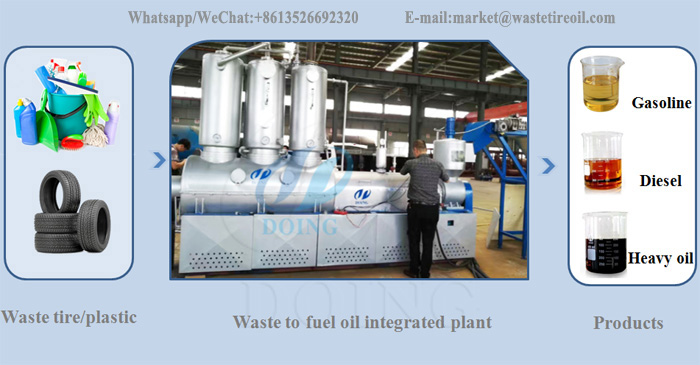 The main products of waste to fuel oil integrated plant
The main products of waste to fuel oil integrated plant
As we know, waste rubber and waste plastic are mainly treated by disinfection landfill, ordinary incineration and plasma incineration. None of these three approaches is the best approach.
Disinfection landfill method can not solve the problem of reducing landfill material and long-term pollution fundamentally, and will cause waste of resources.
The waste rubber and plastics are treated by incineration method, which is simple to operate and complete, but has a great pollution to the environment.
Plasma incineration method is very scientific. All the heat energy is used to generate electric energy for recycling, and the material utilization is also very thorough. However, its high cost (the investment of the whole equipment is between 200 million and 300 million RMB) and its high technical application requirements make it not available for general promotion in a short time.
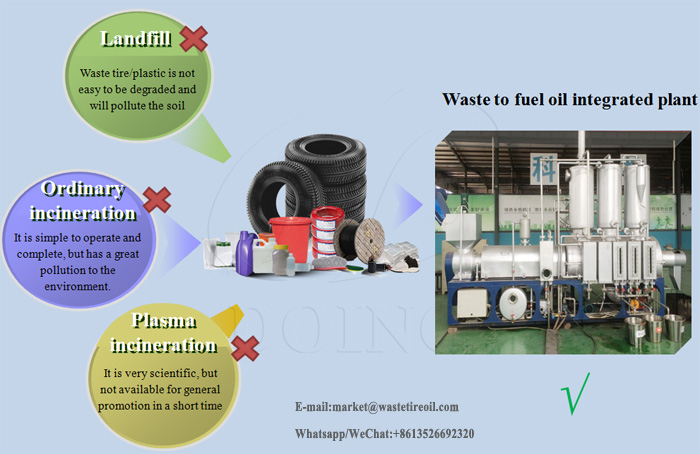 Waste to fuel oil integrated plant is the best approach
Waste to fuel oil integrated plant is the best approach
The waste to fuel oil integrated plant adopts combination of physical and chemical methods to convert the waste rubber plastics into light fuel oil, carbon black and liquefied petroleum gas (LPG), which are three kinds of social renewable resources with extensive use value. Invest waste into fuel oil projects has the characteristics of high economic efficiency, low investment, easy to grasp and popularization.
Therefore, waste to fuel oil integrated plant has attracted the attention of many domestic and foreign customers.
Main advantages of waste to fuel oil integrated plant:
1. The comprehensive design includes pyrolysis, distillation and fractionation processes, so that diesel, gasoline and heavy oil can be obtained at the same time;
2. PLC automatic control and network remote monitoring can be achieved, high technology content, safe and reliable;
3. Automatic continuous feed and discharge system;
4. There is no emission of harmful gases, liquids and solid substances except carbon dioxide in the whole process;
5. Low energy consumption, low noise, strong adaptability to water and electricity environment;
6. easy to operate, low labor intensity.
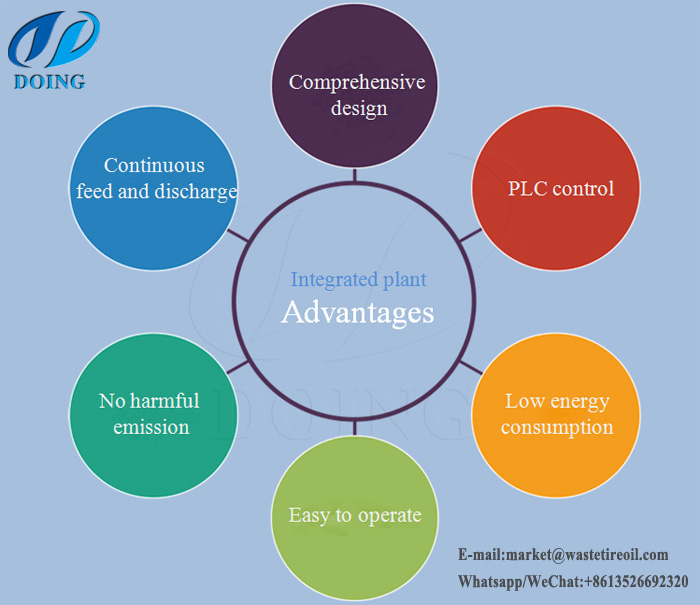 Advantages of waste to fuel oil integrated plant
Advantages of waste to fuel oil integrated plant
Main work flow of waste to fuel oil integrated plant
1. Feed
Before the plant starts to work, it is necessary to crush the waste plastic or rubber into small pieces less than 3-5cm, which will be automatically and continuously fed by the waste to fuel oil integrated plant.
2. Remove dioxins by preheating
As is known to all, dioxins are easily produced by various waste combustion processes, especially chlorine substances, such as PVC plastics, paper mill waste, household waste and so on. The emission of dioxins can cause serious problems to the environment and human body. Therefore, careful treatment and removal should be carried out before waste plastic or rubber releasing dioxins into the air.
3. Pyrolysis
After the removal of dioxins, the plastic or rubber melt is pushed into a mobile bed pyrolysis unit heated by a combustion engine. The pyrolysis is carried out under the process temperature and pressure to generate pyrolysis gas and carbon black, and the carbon black is discharged and collected by the slag discharging device.
4. Feed the pyrolysis gas into the catalytic tower for catalytic reforming to generate oil vapor and mixed oil vapor of petroleum liquefied gas;
5. Mixed oil vapor will be transported into the fractionator, and the fuel oil that fractionated is sent to light oil collector and heavy oil collector respectively;
6. Transport the tail gas of the fractionator into the condensing tower to condense the residual light oil in the tail gas and send it to the light oil collector;
7. Feed the non-condensable gas into the compressor and press it into the liquefaction device to make liquefied gas and put it into the storage tank:
8. Send the harmful gas removed from the second item to the neutralizer for reaction with lye, which will generate the solution of salt and water, and then spray the spray desiccant to remove water to get dry matter salt and collect it.
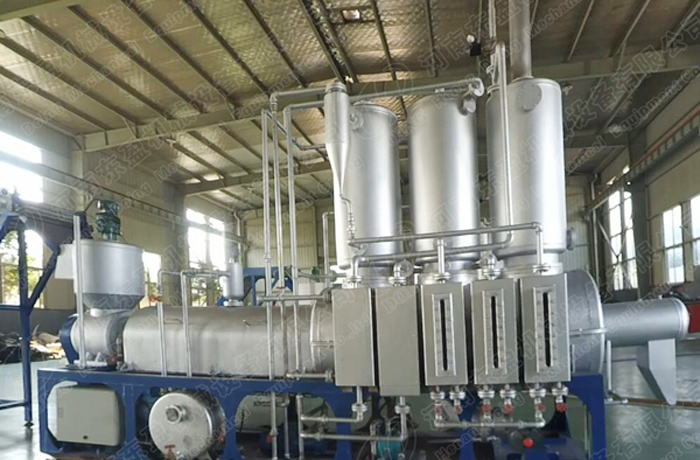 Waste to fuel oil integrated plant
Waste to fuel oil integrated plant
Waste to fuel oil integrated plant can realize the intelligent management by setting and automatically detecting parameters such as flow rate, speed, temperature and pressure. The operation of the plant can also be monitored in real time through the Internet remote monitoring device.
Technical Parameters of waste to fuel oil integrated plant
|
Item |
Content |
|
|
|
Inputs |
Waste tire, plastic, medical waste, multiple solid waste |
||
|
Outputs |
Diesel, gasoline, heavy oil, carbon black, uncondensable gas |
||
|
Model |
Capacity |
Power |
Weight |
|
1.5T/D |
15KW |
6T |
|
|
2.5T/D |
20KW |
8T |
|
|
5T/D |
35KW |
10T |
|
|
10T/D |
50KW |
12T |
|
|
15T/D |
65KW |
15T |
|
|
20T/D |
80KW |
20T |
|
|
Machine type |
Continuous machine |
||
|
Operation system |
Fully automatic PLC control system |
||
|
Reactor material |
Q345R/Q245R/310S+boiler plate/stainless plate |
||
|
Thickness |
12mm/14mm/16mm |
||
|
Heating type |
Indirect heating |
||
|
Heating fuel |
Fuel oil, LPG, Natural gas |
||
|
Cooling type |
Circulating water cooling |
||
|
Land occupy size |
Take 10T/D machine as an example, it’s about 150 - 200 square meters( Width:5-10m, Length:15-20m, Height: 8m) |
||
|
Required workers |
1-2 workers per shift |
||
|
Remarks |
The bigger plant like 30T/D, 50T/D,100T/D could be made according to order. |
||
The Final Products & Applications
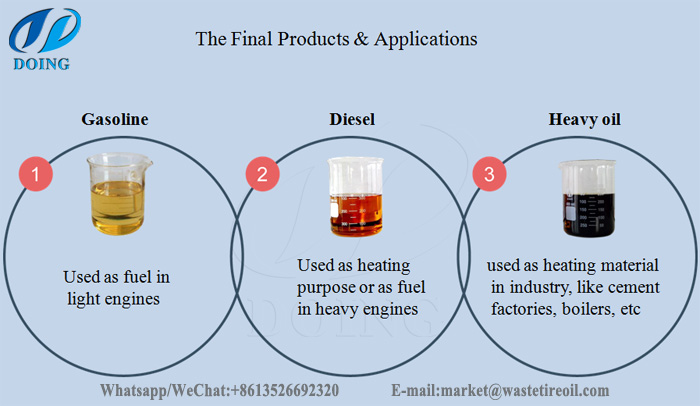 The Final Products & Applications
The Final Products & Applications
1. Diesel
Which can be used as heating purpose or as fuel in heavy engines.
2. Gasoline
It can be used as fuel in light engines.
3. Heavy oil
It is used as heating material in industry, like cement factories, boilers, etc.
4. Carbon black
The carbon black can be further processed.
It can be briquetted into pellet as heating material to replace charcoal, wood, etc. Besides, it can be refined to small meshes for making shoe soles, paint, new rubber, etc.


